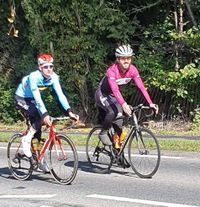E3 Saxo Bank Classic will use robots to make sure fans are Covid-19 safe
The Belgian one-day race is also using new safety barriers at the finish line as the race focuses on safety


E3 Saxo Bank Classic announced new safety measures which curiously include the use of robots that will help keep people Covid-19 safe.
The race, formerly known as E3 Harelbeke, announced the new safety measures ahead of the 2021 edition later this month, complete with new Covid-19 law-enforcement robots that will be going around the crowd to check if they're wearing masks and social distancing.
The company behind this futuristic idea is Zorabotics. The robots will count the people that are present in a certain room, measure the temperatures of those present and will instruct people to wear a mask correctly, so over their mouth and nose.
Zorabotics founder, Fabrice Goffin, told Reuters TV: "The big advantage of this robot relative to a fixed terminal is that the robot can move, can go towards people, can speak to people and speak in their native tongue. It speaks more than 53 languages,"
The robots have already been in Belgian hospitals, care homes and hotels since 2013 but Goffin sees a more varied future thanks to its ability to detect fevers. They can not diagnose Covid-19 directly, but they can help.. The robots cost about €30,000 (£25,000) and have been shipped around the world.
The second, perhaps more important, safety measure the race has taken is with the use of the new Boplan safety barriers, these barriers are said to be far safer than the ones normally used in some of the top bike races, a major talking point after last year saw Fabio Jakobsen (Deceuninck - Quick-Step) crash through the barriers on stage one of the Tour of Poland.
The latest race content, interviews, features, reviews and expert buying guides, direct to your inbox!
One of the aims of the barriers in the repetitive patterns supposedly create a tunnel effect at speed which should make the riders want to stay more central, rather than spreading to right next to the barriers.
If riders did end up coming into contact with the barriers, they will be filled with water to weight them down and will be locked together, which means they will not move if a rider or riders crash into them.
The UCI recently stated that lightweight barriers that are not secured and can easily move will no longer be allowed, as well as any signage that comes out from the barriers.
When arch structures are used to show a line for intermediate sprints or KoM summits, barriers must not suddenly narrow the road, and if it does narrow, a marshal should be present with a yellow flag and whistle to warn the riders. Arches should also themselves not narrow the road.
“All these measures, which are solutions to concerns expressed by different stakeholders, will make road cycling safer for its main players, the riders,” UCI President David Lappartient said. “It is now essential for everyone to respect the new regulations, which the UCI will continue to work on improving, always in consultation with all those concerned.”
>>> Peter Sagan to race Volta a Catalunya as he continues comeback from coronavirus
E3 takes place on March 26 with the biggest names in the Classics side of the sport all down to race. Last year's race was cancelled due to coronavirus, but the defending champion, Zdenek Štybar (Deceuninck - Quick-Step) is down to race along with a very strong team as usual.
Deceuninck will be facing the challenge from Wout van Aert (Jumbo-Visma) and Mathieu van der Poel (Alpecin-Fenix) as well as many other huge names on the list taking on the important build up race for the Tour of Flanders and Paris-Roubaix.
Hi, I'm one of Cycling Weekly's content writers for the web team responsible for writing stories on racing, tech, updating evergreen pages as well as the weekly email newsletter. Proud Yorkshireman from the UK's answer to Flanders, Calderdale, go check out the cobbled climbs!
I started watching cycling back in 2010, before all the hype around London 2012 and Bradley Wiggins at the Tour de France. In fact, it was Alberto Contador and Andy Schleck's battle in the fog up the Tourmalet on stage 17 of the Tour de France.
It took me a few more years to get into the journalism side of things, but I had a good idea I wanted to get into cycling journalism by the end of year nine at school and started doing voluntary work soon after. This got me a chance to go to the London Six Days, Tour de Yorkshire and the Tour of Britain to name a few before eventually joining Eurosport's online team while I was at uni, where I studied journalism. Eurosport gave me the opportunity to work at the world championships in Harrogate back in the awful weather.
After various bar jobs, I managed to get my way into Cycling Weekly in late February of 2020 where I mostly write about racing and everything around that as it's what I specialise in but don't be surprised to see my name on other news stories.
When not writing stories for the site, I don't really switch off my cycling side as I watch every race that is televised as well as being a rider myself and a regular user of the game Pro Cycling Manager. Maybe too regular.
My bike is a well used Specialized Tarmac SL4 when out on my local roads back in West Yorkshire as well as in northern Hampshire with the hills and mountains being my preferred terrain.
